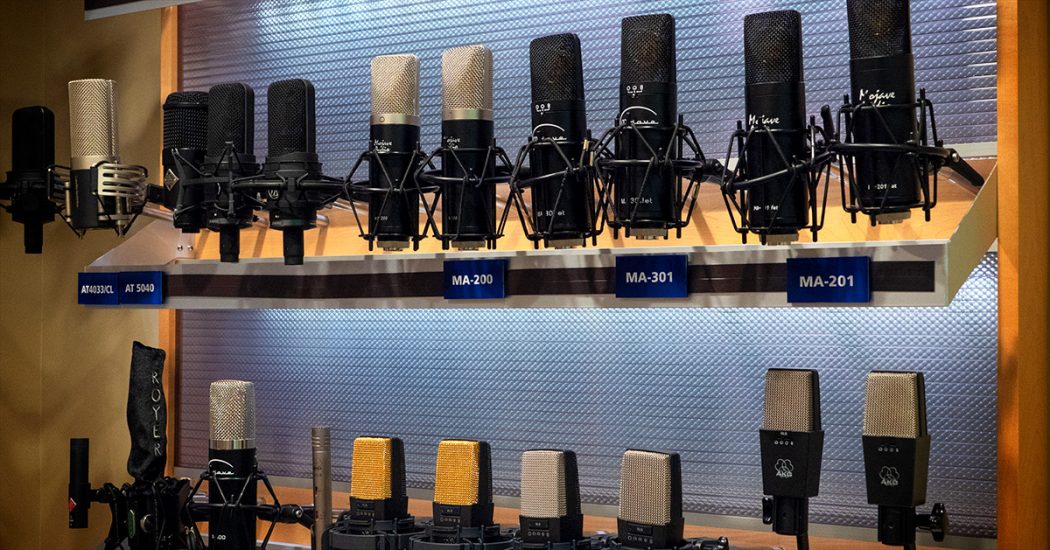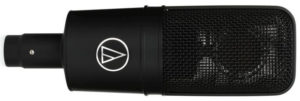
The best mic locker isn’t necessarily the biggest or most expensive. It’s the one that suits your needs and budget. Fortunately, building a mic locker of your own doesn’t need to break the bank. Options abound today, from vintage clones and classics to modern mics and modelers, for prices that are, historically speaking, downright shocking.
The following microphones have been hand selected by Sweetwater staff for their utility, renown, and value. We feel confident that any one of these mics, in the right hands and for the right application, is capable of producing some truly great and lasting recordings.
Microphone Recommendations by Type
Dynamic

Due to their mechanical nature, dynamic microphones tend to be robust and relatively inexpensive. This makes them a great starting point for the fledgling mic locker. Even so, dynamic mics endure as the choice of professional recording engineers for such sources as guitar amps, drums, and even vocals.
Our picks
- Shure SM57 — A true jack-of-all-trades, and the de facto snare and guitar amp mic for many. Get a good ’57, and you’ll never outgrow it.
- Shure Beta 58A — Performs like the perennial SM58 but has an extended frequency response and tighter polar pattern. While the regular ’58 can be a great studio mic for screamers, dynamic singers, and hip-hop artists, it typically takes some sweetening. The Beta gets you one step closer, for not a whole lot more dough.
- Electro-Voice ND46 — One of our favorite kick drum mics of recent years. We’d put this one up against any of our studio mainstays. It’s great for bass amps and floor toms, too; the integrated locking yoke makes it easy to position the ND46 on any source.
- sE Electronics V7 — Another relative newcomer. The V7 sounds quite capable on snares and toms, acoustic guitars, guitar amps, and even vocals. Thoughtful features include an integrated shockmount to reduce handling noise, interchangeable black and red screens, and a roll-stopping beveled edge.
- Electro-Voice RE320 — This mic is a modern-spec’d and sharper-dressed chip off the classic broadcast gem, the RE20. Like the original, the ‘320 lends big, broad bass to vocalists. But a quick swipe of the voicing switch adds a kick drum EQ curve that would make classic RE20 users green with envy. Variable-D technology and a lightweight neodymium element give this mic a fast, uniform pickup, even up to 180° off-axis, to capture excellent detail in a range of voices and acoustic sources.
- Sennheiser e906 — If you’ve got the budget for a mic to dedicate to your guitar amp, the e906 is in a class all its own. More versatile than the ‘609 and way more affordable than a used ‘409, the e906 has a knack for capturing the true character of your favorite combo. The lollipop shape makes it easy to position, too.
Large-diaphragm Condenser (LDC)

The consummate studio mic, the LDC is best known for its sheen and exaggerated low end, along with a higher sensitivity that takes well to weaker preamps. A lead vocal is where you’ll typically see this microphone, though in point of fact, LDCs occupy a wide swath of recording real estate: drum overheads, strings, room mics, and pretty much anything.
Our picks
- sE Electronics X1 S — Perhaps no mic better illustrates the point that price doesn’t always equal performance. The X1 S is packed with all the pro features you could reasonably want, including a -20dB pad and 100Hz highpass filter. And most importantly, it sounds good, with excellent accuracy, dynamics, and a balanced frequency response.
- RODE NT1-A — Present, harmonically neutral, and easily one of the quietest mics in its class, the NT1-A excels as a vocal mic and will surprise you with its high 137dB SPL handling on loud sources like guitar cabs and drum overheads.
- Warm Audio WA-87 — This affordably priced ’87 tips its hat to a certain German FET studio condenser from the 1970s. And you know what? Color us impressed. It’s warm, present, big, forgiving, and capably equipped to propel vocals, acoustic guitar, and guitar cabs to the front of a mix, with audiophile components — Fairchild FETs, WIMA film caps, and a Cinemag output transformer — tucked away inside.
- Avantone Pro CV-12 — This tube condenser is famous for its starring role in Taylor Swift’s Fearless and some of Nick Jonas’s studio work. The CV-12 exhibits classic tube character that pairs well with vocals, strings, and acoustic guitar. Its build quality, style, and performance rival that of tube mics costing many times more.
- Audio-Technica AT4040 — This versatile, competitively priced condenser has appeared on best-of lists for the last 15 years. We’re proud to say it still holds up today, with big vocal authority and the speed to capture auxiliary percussion and acoustic guitars.
- Aston Microphones Origin — This metal-mouthed marvel has already gained a reputation for its openness and transparency on singers and voice-over artists, with integrated mesh-knit filtering to neutralize pops and unwanted sibilance. Pair with a character preamp, and the Origin covers a ton of ground.
Small-diaphragm Condenser (SDC)

The calling card of the SDC is its ability to capture quick and delicate transients. You’ll typically see these on acoustic guitars and pianos in pairs, on hi-hats and cymbals, and spot-miking orchestral instruments. The SDC’s small profile and extended frequency response give it the edge for coincident (XY) and near-coincident (ORTF, NOS) stereo miking applications.
Our picks
- Behringer C-2 pair — That’s right. A matched pair of full-frequency pencil condensers, with pads and highpass filters, for an unbelievable price. Throw these on a piano or over a drum kit, and you’re golden. An included stereo bar and carry case sweeten the deal.
- Shure SM81 — This is another mic you’re unlikely to outgrow. Present, fast, smooth, and three-dimensional, the SM81 is a first choice for many studio engineers. Place it at the neck joint of an acoustic guitar or use as a mono overhead over a drum kit, and you won’t want for much sweetening. A 3-position bass roll-off saves EQ work down the line.
- RODE NT5 pair — These little beauties hold their own against another particularly well-regarded champagne-colored SDC, at a massive savings to the user. The NT5’s realistic high-end detail, low self-noise, and high SPL handling equip this pair for just about any studio application: flute, mandolin, guitar, drums, and even voice.
- sE Electronics sE8 pair — Well priced and exceptionally linear, the sE8s are Sweetwater’s budget pick for what-you-hear-is-what-you-get miking applications. This pair’s hand-tensioned gold-sputtered capsules are tuned to capture sources just as you hear them in the room, from choirs and orchestral instruments to acoustic guitars and drums. The 2-position highpass filters and pads eliminate distortion and mud for clean, quiet, natural pickup. The sE8s ship factory matched in a metal road case with clips, screens, and a stereo bar.
Ribbon

Ribbon mics may be the mussels of the recording regale. Their reputation for being dull, fragile, low-output, and expensive has turned off many users before they ever try one for themselves. To the audio gourmand, however, a well-built ribbon mic imparts life and color where others fail. Drum rooms, guitar cabs, strings, brass instruments, and even vocals are particular strengths of this type.
Our picks
- sE Electronic Voodoo VR2 — This active ribbon sounds great through virtually any preamp, even at the prosumer level. Its sweetened EQ curve and boosted output capture air and life that others — even the heavy hitters — may miss. Plus, it’s insanely rugged to boot: from the motor assembly to the housing, this mic is built to last.
- Golden Age Project R2 MKIII — The Golden Age Project R2 MKII makes a great introduction to the world of ribbons, not only for its modern ribbon performance — creamy, mellow, full-figured, and fast — but also because it takes most preamps well. Its 137dB SPL handling means you can park it in front of a dimed guitar amp without hesitation.
- Royer R-10 — Royer has done more to revitalize the ribbon mic than just about any other industry presence. The R-10 builds on the tech and reputation of Royer’s award-winning R-121, beloved by the likes of Jerry Finn, Steve Albini, and countless producers worldwide, with a ruler-flat frequency response and overload-proof 160dB SPL rating. From guitar cabs to voice and acoustic instruments, the R-10 is an exceptional value. It’s built for abuse, too — a 3-layer windscreen and silicon grommet mounting system protect the ribbon element from damage through air pressure and accidental falls. Be advised that this mic requires lots of clean gain, so be sure to pair it with a quality mic pre or a product like the Cloudlifter CL-1.
Modeling

A new type of microphone has emerged over the last several years: the modeling mic. Each of these options is a virtual mic locker unto itself, spanning several decades of classic mics and preamp pairings.
Our picks
- Slate Digital VMS ML-1 — Steven Slate and company are perhaps the best known in this brave new world of mic and preamp modeling. The Virtual Microphone System offers a wealth of world-class virtual condenser, tube, and ribbon mic models and preamp modules for pennies on the dollar. The ML-1 itself is a well-built LDC with a shockmounted gold Mylar capsule and an exceptionally linear frequency response. Eight mic and preamp modules are included with purchase at the time of this writing; additional modules are available for purchase directly through Slate Digital. The small-diaphragm ML-2 is also available.
- Townsend Labs Sphere L22 — The Sphere L22 is a bit of a departure from the VMS and Edge systems. Not only can this system quite capably re-create the response of the standards and vintage classics, but its dual elements and Sphere DSP software also let you rotate, expand, and contract polar patterns after the fact, giving you a scary amount of control over sweet spots, proximity effect, bleed, and coloration. Most impressive is Sphere’s throw-and-go recording freedom; with all you can do in the software, the agony of getting the mic right at the source is significantly diminished.
Remember: Sweetwater is here to help you build the mic locker of your dreams and means. Don’t hesitate to contact your Sales Engineer at (800) 222-4700 to discuss any of the microphones listed in this feature.







